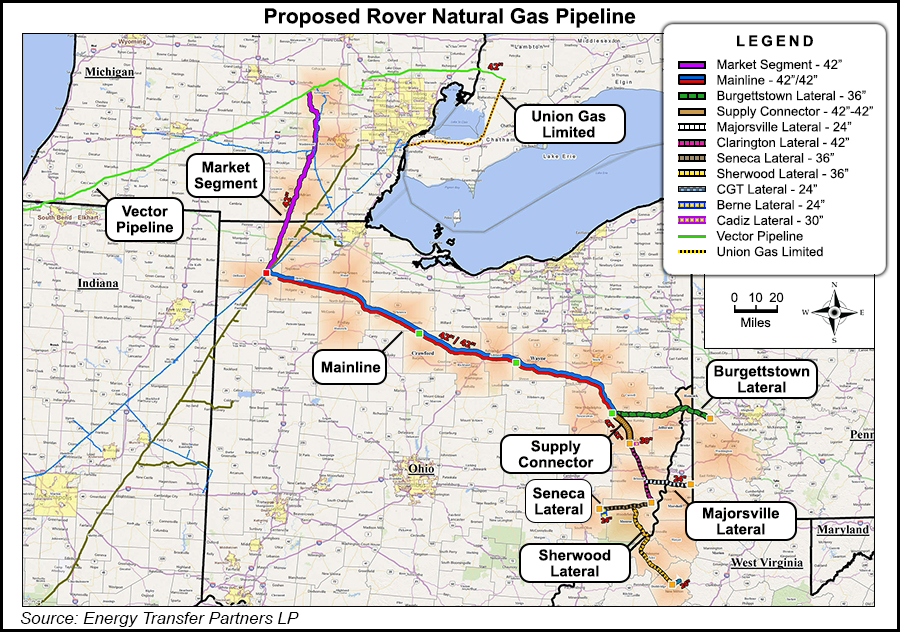Regulatory | Infrastructure | NGI All News Access | NGI The Weekly Gas Market Report
Expedited FERC Approval Sought for $4.22B Rover Pipeline Project
Rover Pipeline LLC has requested that FERC approve authorization to construct 711 miles of supply laterals and mainlines, compression and other facilities to carry Marcellus and Utica shale gas from West Virginia, Pennsylvania and Ohio to an interconnect with Vector Pipeline in Michigan by the second quarter of 2016.

Expedited approval would allow Rover to begin construction in June or July 2016, enable it “to maximize consideration of environmental and agricultural factors, along with constructing during summer and fall months when conditions are less harsh and more favorable to workers,” according to a filing Monday (Nov. 9) with the Federal Energy Regulatory Commission [CP15-93]. “Furthermore, it will enable Rover to address the takeaway transportation capacity needs of its producer shippers, many whose production is currently shut in and significantly bottlenecked, to Defiance, OH, no later than January 2017, and to the Vector Pipeline by mid-2017.”
Delaying authorization beyond 2Q2016 “will jeopardize Rover’s ability to complete the work necessary to place its facilities into service in the safest and most environmentally sensitive and timely manner…[and] likely will extend Rover’s construction timeline for up to an additional year and will similarly strand Marcellus and Utica production for the same period of time,” the company said.
Rover was announced by Energy Transfer Partners LP (ETP) last year and within a few months the project was fully subscribed at 3.25 Bcf/d (see Daily GPI, Oct. 31, 2014; June 26, 2014). ETP filed its formal application with FERC earlier this year (see Daily GPI, Feb. 23).
As designed, the $4.22 billion Rover would include dual 42-inch diameter pipelines from the beginning of its Mainlines A and B near Leesville in Carroll County, OH, to the Midwest Hub. Rover would have delivery meters at the Midwest Hub to deliver gas into Panhandle Eastern Pipe Line Co. LP and ANR Pipeline Co. Rover has executed precedent agreements with Panhandle and Trunkline Gas Co. LLC for firm capacity.
“By using existing capacity on the Panhandle and Trunkline Gas pipelines, Rover will deliver approximately 750,000 Dth/d to Panhandle, which will redeliver volumes via backhaul to Trunkline Gas’ Zone 1A,” the company said in its February filing. “Rover will also be capable of delivering up to approximately 1.7 Bcf/d to ANR.”
From the Midwest Hub, Rover would be a single 42-inch diameter pipeline — the project’s Market Segment — with capacity to carry up to 1.3 Bcf/d to a proposed interconnection with the Vector system in Livingston County, MI.
In September, a law firm representing more than 200 landowners who could be impacted by the proposed pipeline asked FERC to delay issuing a draft environmental impact statement for the project on the grounds that, among other things, Rover had filed insufficient details about the project’s environmental impacts (see Shale Daily,Sept. 17).
© 2024 Natural Gas Intelligence. All rights reserved.
ISSN © 1532-1231 | ISSN © 2577-9877 | ISSN © 1532-1266 |
